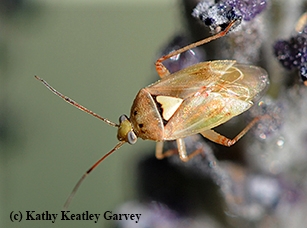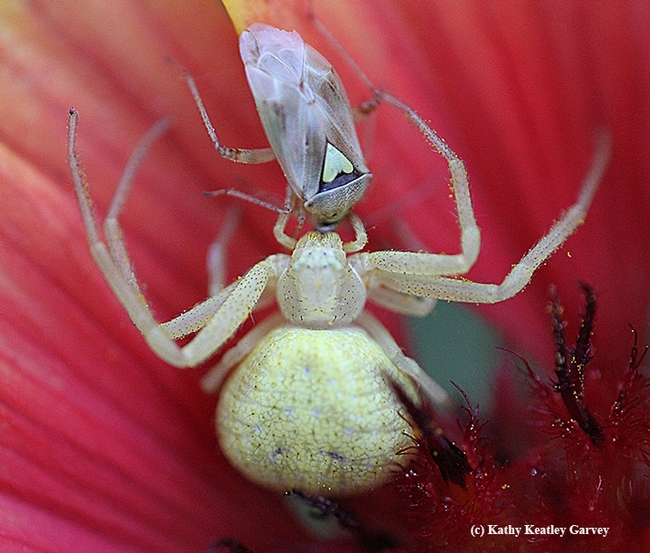
A crab spider nailed a major pest, a lygus bug, Lygus hesperus. It's something you don't see very often. But you appreciate very much.
A lygus bug made the fatal mistake of feeding on a blanket flower (Gaillardia) where the cunning spider was lurking and waiting for prey...er...dinner.
A venomous bite and it was all over.
The lygus bug is easily distinguishable by its triangle or V shape on its back. The V does not stand for "Victory" when it's attacked and consumed by a crab spider.
Do not feel sorry for lygus bugs. Their piercing mouthparts suck the lifeblood (juices) right out of the plant tissues. You may have seen them feeding on berries, beets and beans. The females lay their eggs in the plant tissues. Their visible path of destruction ranges from discoloration and deformation to leaf-curling and lesions.
"Lygus bug adults are about 0.25 inch long and 0.1 inch (2.5 mm) wide, and flattened on the back," according to the UC Statewide Integrated Pest Management Program (UC IPM). "They vary in color from pale green to yellowish brown with reddish brown to black markings, and have a conspicuous triangle in the center of the back. Nymphs resemble adults, but are uniformly pale green with red-tipped antennae; larger nymphs have five black spots on the upper body surface. Nymphs do not have wings." (Read UC IPM Pest Management Guidelines for more information and how to control them.)
The some 200 host plants of lygus bugs include Russian thistle, wild radish, London rocket, black mustard and goosefoot.
Their enemies are many. "A parasitic wasp, Anaphes iole, which attacks lygus eggs, is available commercially and can be used for inoculative releases," UC IPM says. "It can reduce lygus populations in strawberry fields; but because thresholds for this pest are very low and adults moving into the field from external sources are not controlled, economically acceptable results may not be achieved. Naturally occurring predators that feed on the nymphal stages of lygus bug include bigeyed bugs (Geocoris spp.), damsel bugs (Nabis spp.), minute pirate bugs (Orius tristicolor), and several species of spiders."
Spiders? Yes, indeed.
Attached Images:
